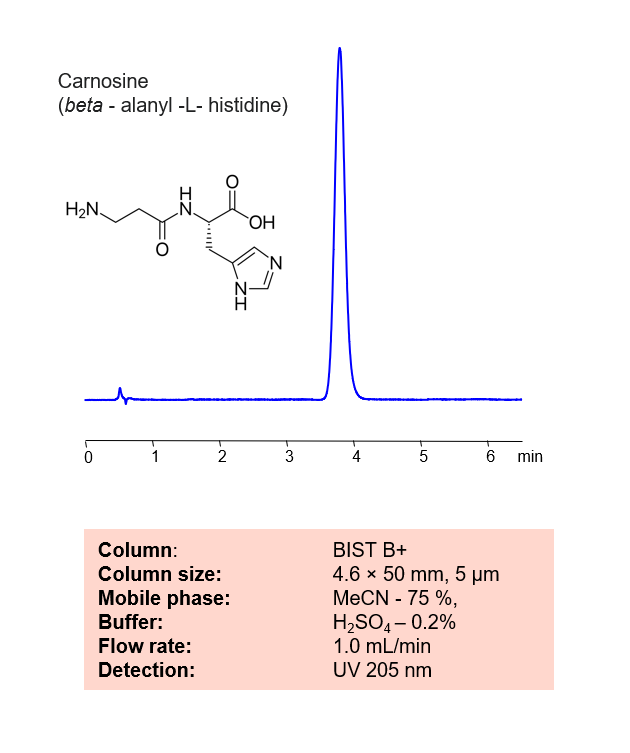| CAS Number | 305-84-0 |
|---|---|
| Molecular Formula | C9H14N4O3 |
| Molecular Weight | 226.23 |
| InChI Key | CQOVPNPJLQNMDC-ZETCQYMHSA-N |
| LogP | -3.3 |
| Synonyms |
|
Applications:
HPLC Method for Analysis of Carnosine (beta-alanyl-L-histidine) on Primesep 100 Column
February 15, 2023
HPLC Method for Analysis of Carnosine (beta-alanyl-L-histidine) on Primesep 100 by SIELC Technologies
Separation type: Liquid Chromatography Mixed-mode

Carnosine is a dipeptide molecule synthesized from beta-alanine and histidine. It is a naturally occurring pH buffer with antioxidant properties found in muscles. This dipeptide can be retained and analyzed on a mixed-mode Primesep 100 column with a mobile phase consisting of water, Acetonitrile (MeCN), and Trifluoroacetic acid (TFA). This analytical method can be UV detected at 215 nm with high resolution and peak symmetry.
High Performance Liquid Chromatography (HPLC) Method for Analysis of Carnosine (beta-alanyl-L-histidine)
Condition
| Column | Primesep 100, 4.6 x 150 mm, 5 µm, 100 A, dual ended |
| Mobile Phase | MeCN/H2O – 20/80% |
| Buffer | TFA – 0.6% |
| Flow Rate | 1.0 ml/min |
| Detection | UV 215 nm |
| Peak Retention Time | 5.21 min |
Description
| Class of Compounds | Phenols |
| Analyzing Compounds | Carnosine (beta-alanyl-L-histidine) |
Application Column
Primesep 100
Column Diameter: 4.6 mm
Column Length: 150 mm
Particle Size: 5 µm
Pore Size: 100 A
Column options: dual ended

HPLC Method for Analysis of Carnosine (beta-alanyl-L-histidine) on BIST B+ Column
January 18, 2023
HPLC Method for Analysis of Carnosine (beta-alanyl-L-histidine) on BIST B+ by SIELC Technologies.
Separation type: Bridge Ion Separation Technology, or BIST™ by SIELC Technologies

High Performance Liquid Chromatography (HPLC) Method for Carnosine (beta-alanyl-L-histidine)
Carnosine is a dipeptide molecule synthesized from beta-alanine and histidine. It is a naturally occurring pH buffer with antioxidant properties found in muscles. Using SIELC’s newly introduced BIST™ method, Carnosine can be retained on a positively charged, antion-exchange BIST™ B+ column. There are two keys to this retention method: 1) a multi-charged, negative buffer, such as Sulfuric acid (H2SO4), which acts as a bridge, linking the positively charged peptide to the positively charged column surface and 2) a mobile phase consisting mostly of organic solvent (such as MeCN) to minimize the formation of a solvation layer around the charged analytes. Using this new and unique analysis method, Carnosine can be separated, retained, and UV detected at 205 nm.
Condition
| Column | BIST B+, 4.6×50 mm, 5 µm, 100A |
| Mobile Phase | MeCN – 75% |
| Buffer | H2SO4 – 0.2% |
| Flow Rate | 1.0 ml/min |
| Detection | UV 205 nm |
| Peak Retention Time | 3.71 min |
Description
| Class of Compounds | Dipeptide |
| Analyzing Compounds | Carnosine (beta-alanyl-L-histidine) |
Application Column
BIST B+
Column Diameter: 4.6 mm
Column Length: 50 mm
Particle Size: 5 µm
Pore Size: 100 A
Column options: dual ended




